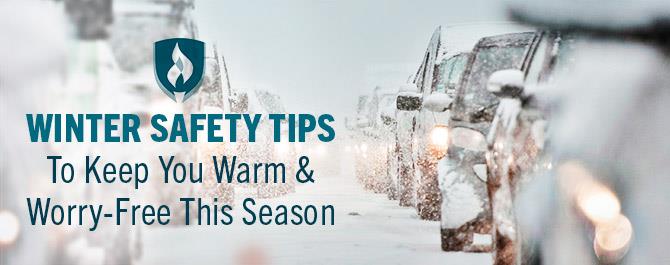Winter Safety Tips to Keep You Warm & Worry-Free this Season
By Lauren Elrick on 12/14/2015

The smell of pine and flaky apple tart is on the air, and you’re donning a few extras layers of clothing these days. As the leaves fall and the first snows start to layer the ground, it’s important to keep in mind that while winter is a unique and beautiful season, it can also carry alarming dangers and fatal hazards if you’re not careful and aware.
If you’re new to a geographical location that gets a lot of snow, it’s especially important that you read up on the conditions of your new environment. Thankfully, all it takes is a few easy preventative safety measures to protect yourself and your family as the days get shorter.
We enlisted some safety experts to gather their advice on a host of winter safety issues that commonly plague northerners. We combine their insight with a little research of our own to include a variety of helpful pointers. So whether you’re hanging holiday lights or driving on an icy road to visit relatives, know that there are extra precautions that you can (and should) be taking.
6 Ways to have a worry-free winter
1. Choose your ladder wisely
After Halloween and Thanksgiving, the holiday lights start blinking in multitudes. From the pointed eaves of your house to the tippy top of the Christmas tree, lights are often strung in hard-to-reach places.
The Laborer’s Health and Safety Fund of North America provides a myriad of tips for ladder safety. Before you clamber up those rungs to get the job done, take a look at the following safety tips that could help you avoid trouble:
- Make sure your ladder is the correct size and that extension ladders have at least one foot of distance from the wall for each four feet of height.
- Always secure the ladder by having someone hold it or by tying it down.
- Wear slip resistant shoes.
- Do not work from the top three steps of the ladder.
- Never leave an unsecured ladder set up unattended.
- Make sure your ladder is set up on firm, level ground.
2. Prep your car for winter driving
Many a driver has been taken by surprise when conditions take an icy turn for the worse. If you haven’t lived in a state where the weather conditions are typically snowy in the winter, a season of driving up north can be quite the experience!
One way to do this is by equipping your vehicle with tire chains to increase traction if you live in a snowy area, as suggested by Rob Infantino, founder and CEO at OpenBay. It’s also smart to make sure to get the mechanics of your car checked out prior to winter so you’re confident things are in tip-top shape.
“Breaking down by the side of the road is a nuisance even in clear, warm weather,” Infantino says. “Getting stuck on the side of a road in a blizzard is even worse – and it can be dangerous!”
You should also ensure you have some emergency items in your vehicle in case you were to have car trouble or get in an accident in sub-zero weather. The National Safety Council (NSC) has prepared a list of emergency items you should make sure to have with you in case of such a crisis:
- Properly inflated spare tire, wheel wrench & tripod jack
- Shovel
- Jumper cables
- Tow & tire chains
- Bag of salt or cat litter for better tire traction or to melt snow
- Tool kit
- Flashlights, reflective triangles or flares
- First aid kit
- Windshield cleaner
- Nonperishable, high-energy foods such as nuts or dried fruit
- Extra blankets, mittens, socks & hat
3. Avoid accidental fires
While it may seem like a long shot, Christmas tree fires, cooking fires and other seasonal fires do happen! December and January are the peak months for house fires, according to the American Red Cross.
Peter Duncanson, director of disaster restoration training for ServiceMaster Restore, claims cooking and candles are the two biggest culprits for the winter house fires his employees respond to. We’re not suggesting you cancel your family holiday feast or throw out your new cinnamon spice candle; just be aware of the dangers and take extra precautions.
Duncanson shares a few helpful tips regarding house fires:
- Practice fire evacuation drills with all members of your household.
- Never leave utensils unattended on the stove while cooking.
- ALWAYS have a fire extinguisher handy in the kitchen.
- Ensure electrical outlets aren’t overloaded with plugs.
- Extinguish candles before leaving the room or going to bed.
- Don’t leave portable space heaters running unattended for an extended period of time.
- Make sure there is a frequently-tested smoke alarm on every level of your home.
- Schedule inspections for furnaces & heating systems prior to winter.
4. Prevent carbon monoxide poisoning
As an invisible, odorless killer, carbon monoxide gas (CO) poisoning is nearly impossible to recognize without a CO detector. December and January are also the most common months for CO poisoning, according to the NSC.
The most important step is making sure you have a CO detector installed in your home, and of course, make sure the batteries are working properly! It may seem like common sense, but you should also avoid heating your home with a gas range or oven. And never let your car run inside an attached garage. These precautions will help keep your risks for CO poisoning at a minimum.
“Make sure that any room you put a space heater in also has good ventilation,” adds Alexander Ruggie, public relations director for 911 Restoration. “This will help to make sure that the carbon monoxide doesn't build up.”
5. Protect against frostbite
It’s easy to assume this dangerous, cold-related condition only strikes those with uncovered skin. You may be surprised to hear this is untrue! Even covered skin can fall victim to frostbite, and this injury happens to be one of the most common each winter.
Frostbite occurs after over-exposure to severe cold and can cause the skin to feel cold and numb and look white, waxy or grayish yellow. If you suspect frostbite, the NSC recommends following these instructions:
- Go inside immediately.
- Seek medical attention.
- Remove any clothing or jewelry that could impair circulation.
- Place dry, sterile gauze between fingers and toes to absorb moisture and ensure they don’t stick together.
- Elevate the affected area to decrease pain and swelling.
6. Keep sickness at bay
It’s no secret that winter is the season of choice for many viral illnesses. The good news is that there are some simple precautions you can take to help keep the germs from attacking your immune system.
While you may have learned it in kindergarten, many still need a gentle reminder to always wash your hands. This is especially essential when you’re in crowded public places, such as the mall or gym. Secondly, make sure you practice other healthy habits, like eating plenty of fruits and vegetables, exercising, drinking lots of fluids and maintaining minimum stress levels.
Stay safe this season!
Following these useful tips will help ensure you and your family stay safe during this cold season. This will give you some peace of mind and allow you to enjoy all of the fun and festivities that come along with it. Share this list with your loved ones to help spread the word!
We know there are many more where these came from. Share any other helpful tips we forgot in the comments below!




